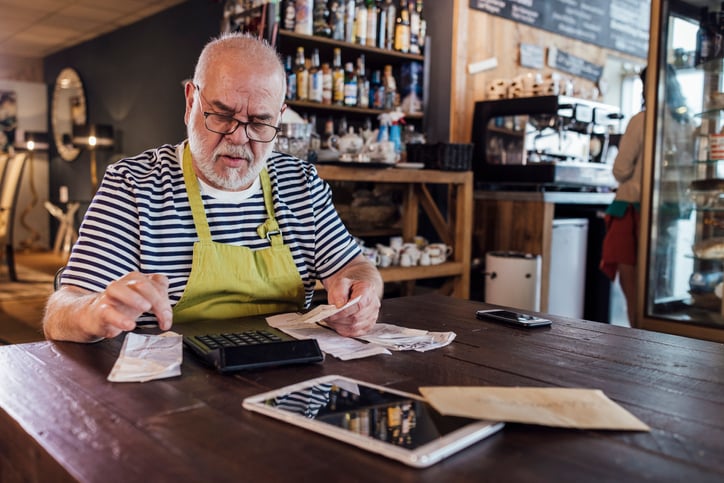From recessions to social shifts, businesses occasionally face uncertainty. But there are ways your business can successfully navigate changing economic and social landscapes.
In this guide, we’ll cover tips on how to deal with business uncertainty with ease.
1. Know your uncertainty level
No matter what industry you’re in, all business ventures entail some level of economic uncertainty.
However, not all uncertainty is created equal. That’s why business experts built a categorization system, ranging from level one (low uncertainty) to four (high uncertainty).
This categorization system can help small business owners identify where they fall. Once they understand what their uncertainty levels are and their cause, they can better understand their current situation and the best path forward. It may also be helpful when it comes to business planning for a recession.
Below we’ll outline the four levels of uncertainty.
Level one: Discrete outcomes that can be predicted
Level one uncertainty is the easiest to deal with from a business perspective. That’s because, in a level one situation, a business is able to accurately predict future outcomes based on current models.
In this case, the term “discrete outcomes” means that there are only a few possible end results that can be closely predicted. For example, if you’re a real estate agent looking to invest in expanding your reach by hiring an email newsletter writer, you can probably predict that you’ll see an uptick in contact requests through email. That’s a discrete outcome.
You’ll know you’re in a level one situation if you can see some straightforward discrete outcomes. Additionally, a level one uncertainty tends to include the following characteristics:
- You have the ability to predict a possible outcome with accuracy
- The market you’re investing in is a relatively stable market
- The uncertainty centers around routine business decisions that involve a slight level of risk exposure
For instance, suppose your restaurant wants to open up a new location in an up-and-coming neighborhood. So far, all reports from other businesses seem to be that their profit numbers are thriving. Because you already know the new location will likely thrive, the venture entails level one uncertainty.
Knowing that you’re at level one uncertainty means you have some stability—you’re taking chances in an environment that’s relatively stable based on business reports and can move forward with some confidence.
Level two: No discrete outcomes, only probabilities
Level two uncertainty is more difficult to navigate than level one uncertainty. In a level two situation, there may be several mutually-exclusive outcomes. As a result, no one outcome can be accurately predicted.
Instead, your business can assign probabilities to each outcome. That means identifying all the things that could happen and making note of the changes that each individual outcome may come to pass.
Further characteristics of level two uncertainty include:
- The inability to predict a competitor’s strategy
- Having multiple business plans
- Risk categorization models that assign a probability
To return to the restaurant scenario, suppose your models suggest that your new location will thrive but can’t give an accurate prediction because a competitor is also opening up a location in the same area. In that situation, there are many more unknown factors at play so it’s more difficult to be certain about what will happen.
By categorizing your uncertainty at level two, you can easily spot where your uncertainty is coming from and create plans to help counteract the source of the risk. For example, if you know your uncertainty stems from a competitor restaurant opening near your new location in that neighborhood, you can create a plan to help differentiate your restaurant experience, creating a competitive advantage. That might mean:
- Making space to host regular events that will draw locals
- Offering unique food and beverage options that stand out in the crowd
- Creating a loyalty rewards program for the neighborhood
Identifying uncertainty creates a pathway to addressing it.
Level three: No discrete outcomes, no probabilities
In a level three situation, a business can’t predict discrete outcomes, nor can they assign probabilities to them. This situation mostly occurs during unstable market conditions or when businesses can’t accurately measure customer demand.
For example, suppose you want to open up a new restaurant location, but don’t know if the area’s demand will create the right market conditions for the franchise’s success. Thus, you are in level three territory.
You can try to remedy this by:
- Speaking to other businesses in regards to their experience in the area
- Take a look at historic data in the neighborhood and other neighborhoods like it
However, sometimes the information isn’t there and the risk is just that—a risk. Level three uncertainty doesn’t mean you’ll be facing failure, it just means that you’ll be entering into a situation that doesn’t have predictable outcomes.
Level 4: Predictions can’t be made at all and models break down
Level four uncertainty is the maximum uncertainty. No predictions can be made because models break down at this level.
This situation mostly arises when an unexpected political, environmental, or social event completely disrupts the market.
For example, suppose you’ve drawn up plans to open up a string of restaurant locations in your county. However, right before you open them, a pandemic hits. Thus, you have no way of predicting how your restaurants will fare given this unexpected event.
Fortunately, level four uncertainty isn’t common and typically turns into lower levels after enough time has passed.
2. Build flexibility into your business model
Flexibility is key when it comes to uncertainty. By being flexible, you’ll be better able to adapt to changing circumstances and navigate business uncertainty.
Flexibility starts with your business model. Here are a few ways to incorporate more flexibility into your business:
Create multiple business plans
If you have only one business plan, you might find yourself up against the wall during periods of high risk. Instead, be flexible by using scenario planning, and creating multiple business plans based on different scenarios.
Flexible business plans typically contain the following:
- Plausible scenarios and effective strategies
- Alternative sources of funding
- Alternative organizational structures
You might also consider running experiments in which you “test” your business plans’ strengths.
For example, suppose one of your plans for starting a pressure washing business or construction business focuses on customer demand. You could see how this plan would work by simulating a situation in which construction demand is at an all-time low. How will you pay for operating costs? How can you move resources around to reach more potential clients?
Knowing the strengths and weaknesses of this plan will help you tremendously should you have to put this plan into action during uncertainty.
Be prepared to pivot
When a business “pivots,” it reorganizes its business model, brand, and purpose to meet customer demand better.
Business flexibility means being open to pivoting should the need arise when uncertainty comes around. It means having the structures already in place so that pivoting to a new product or industry is as easy as counting to ten.
Common examples of business pivoting include:
- A distillery switching to hand sanitizer production
- A therapy practice switching to a virtual business
- A restaurant offering takeout only
- A clothing store changing their marketing approach
Based in San Diego, CandyMeUp is a small candy business that knows a thing or two about the power of pivoting.
When the COVID-19 pandemic brought tons of level four uncertainty, they decided to switch to a totally online retail operation. They subsequently became popular on social media and their sales have since been as sweet as their products.
Although CandyMeUp probably didn’t plan to pivot, just being prepared to pivot will help you navigate uncertainty.
3. Stay on top of your finances
Staying on top of your finances is one of the best ways to deal with uncertainty in the market.
Having an accurate picture of your cash inflow vs. outflow allows you to move money around when needed and access any “rainy day” funds.
When considering your finances, note the following:
- Average monthly leads – Leads refer to your business prospects. For example, if your business sells mattresses, a lead is a customer (or business) interested in your mattresses. Your average number of monthly leads can help you gauge the strength of your business.
- Revenue – Your revenue refers to the total income brought in from the sale of goods and services.
- Net income – To calculate your net income, subtract your expenses from your revenue.
- Profit margin – A measure of profitability, profit margin refers to your profit as a percentage of revenue.
This information will enable you to create cash flow forecasts that can help you predict where you’ll be financially after a specified time. In short, the more financial information you have, the less your business will be plagued by financial uncertainty.
4. Increase transparency and communication
Increased transparency and communication can help your business stay afloat during difficult times. To this extent, maintaining a website is a fantastic way to keep lines of communication open.
Not only can a website help drive sales, but it can also alert customers to changes in hours, prices, and events.
In other words, a website can be an island of certainty in an otherwise uncertain sea.
Birmingham’s Watts Realty Company is a small real estate agency with a big-time grasp on communication. In addition to easily-navigable links for services, their website has a blog that keeps customers apprised of what’s going on with their business.
Connect with your community
It’s important to remember that you may not have to face uncertainty alone. Many businesses have communities that can support them when times are tough.
If you’re fortunate to have a supportive community, one of the best things you can do is stay connected to them through Nextdoor.
By creating a Nextdoor Business Page, you can use business posts to get the word out about changes to your business. You can also keep customers apprised of deals, operating hours, and events.
In times of uncertainty, Nextdoor is there.
5. Embrace uncertainty
Sometimes, the best thing you can do during an uncertain time is to embrace it. This means understanding that while you may not be able to control every situation, you can control how you are managing uncertainty.
To embrace uncertainty, do the following:
- Listen to every argument – Depending on your level of uncertainty, you might receive many different opinions on how to proceed. Instead of focusing solely on one opinion, listen to every argument your coworkers present. You can then decide which route is the best route to take and proceed from there.
- Don’t be afraid to “swim against the tide” – While you should lend your ear to every argument, you shouldn’t be afraid to go with your instincts if you think doing so will help you navigate uncertain times.
- Realize that there may not be one right answer – Uncertain times are uncertain for a reason; if there were one right answer, the path forward would be clearer than mountain spring water. Embracing uncertainty means understanding that there likely isn’t one right answer, and that’s okay. All you need to do is go with the option you think best enables your business to succeed.
Navigate uncertainty with Nextdoor
Risk and uncertainty in business are unavoidable. However, there’s one thing that’s absolute: the power of community.
With Nextdoor, you can create a Business Page and connect with your community. That way, you can support your local community while your local community supports you.
Get set up on Nextdoor today and start turning uncertainty into opportunity.








